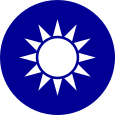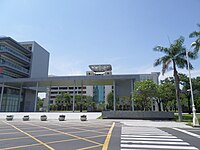President of the Republic of China
| President of the Republic of China | |
|---|---|
| 中華民國總統 | |
| Appointer | Direct election[note 1] or via succession |
| Term length | 4 years; renewable once |
| Precursor | Chairman of the National Government (1925–1948) |
| Formation | 1 January 1912 (provisional, in Mainland China) 25 October 1945 (Taiwan handover) 20 May 1948 (current form) |
| First holder | Sun Yat-sen (as Provisional President) |
| Unofficial names | President of Taiwan |
| Deputy | Vice President |
| Salary | NTD 6,420,000 annually[1] |
| Website | english |
| President of the Republic of China | |
|---|---|
Tâi-lô | Tiong-kok Tsóng-thóng |
台灣總統
| Transcriptions |
|---|
 |
|---|
|
|
The president of the Republic of China, commonly known as the president of Taiwan, is the head of state of the Republic of China (Taiwan) as well as the commander-in-chief of the Republic of China Armed Forces. The position once had authority of ruling over Mainland China, but its remaining jurisdictions has been limited to Taiwan, Penghu, Kinmen, Matsu, and other smaller islands since the conclusion of the Chinese Civil War.
Originally elected by the National Assembly, the presidency was intended to be a ceremonial office with no real executive power as the ROC was originally envisioned as a parliamentary republic.[2] Since the 1996 presidential election, the president is directly elected by plurality voting to a four-year term, with incumbents limited to serving two terms. The incumbent, Tsai Ing-wen, succeeded Ma Ying-jeou on May 20, 2016, to become the first female president in the history of Taiwan.
Qualifications
- The Presidential and Vice Presidential Election and Recall Act[3] states that a candidate for president or vice president must be a citizen of the Republic of China, at least 40 years old, and a resident of the Taiwan Area for a period of no less than 15 years with a physical presence of no less than 6 consecutive months.
- The following persons shall not be registered as candidates for the president:
- Military personnel
- Election officials
- People who hold foreign nationality or who do not reside in the Free Area of the Republic of China
- People who have restored their nationality or acquired their nationality by naturalization
Powers
The president is currently elected by a
The Constitution of the Republic of China names the president as head of state and commander-in-chief of the Republic of China Armed Forces (formerly known as the National Revolutionary Army). The president is responsible for conducting foreign relations, such as concluding treaties, declaring war, and making peace. The president must promulgate all laws and has no right to veto, but can approve or not the veto proposed by the Executive Yuan (Cabinet). Other powers of the president include granting amnesty, pardon or clemency, declaring martial law, and conferring honors and decorations.
The president may, by resolution of the Executive Yuan Council, issue emergency decrees and take all necessary measures to avert imminent danger affecting the security of the state or of the people or to cope with any serious financial or economic crisis. However, such decrees shall, within ten days of issuance, be presented to the Legislative Yuan for ratification. Should the Legislative Yuan withhold ratification, the said emergency decrees shall forthwith cease to be valid.
The president may, within ten days following passage by the Legislative Yuan of a no-confidence vote against the premier, declare the dissolution of the Legislative Yuan after consulting with its president. However, the president shall not dissolve the Legislative Yuan while martial law or an emergency decree is in effect. Following the dissolution of the Legislative Yuan, an election for legislators shall be held within 60 days.
The president can appoint
The Constitution does not clearly define whether the president is more powerful than the premier, as it names the Executive Yuan (headed by the premier) as the "highest administrative authority" with oversight over domestic matters while giving the president powers as commander-in-chief of the military and authority over foreign affairs. Prior to his election as president in 1948, Chiang Kai-shek had insisted that he be premier under the new Constitution, while allowing the president (to which Chiang nominated
After the 2000 election of Chen Shui-bian as president, the presidency and the Legislative Yuan were controlled by different parties, which brought forth a number of latent constitutional issues, such as the role of the legislature in appointing and dismissing a premier, the right of the president to call a special session of the legislature, and who has the power to call a referendum. Most of these issues have been resolved through inter-party negotiations.
Succession
| Part of a series on Orders of succession |
| Presidencies |
|---|
The Constitution of the Republic of China gives a short list of persons who will succeed to the presidency if the office were to fall vacant. According to the Additional Articles of the Constitution, Article 2:[7]
Should the office of the vice president become vacant, the president shall nominate a candidate(s) within three months, and the Legislative Yuan shall elect a new vice president, who shall serve the remainder of the original term until its expiration.
Should the offices of both the president and the vice president become vacant, the president of the Executive Yuan shall exercise the official powers of the president and the vice president. A new president and a new vice president shall be elected in accordance with Paragraph 1 of this article and shall serve out each respective original term until its expiration. The pertinent provisions of Article 49 of the Constitution shall not apply.
As no president of the Executive Yuan (also known as the premier) has ever succeeded to the presidency under these provisions (or their predecessors, under Article 49), it is untested whether, should the office of the premier be vacant as well, whether, pursuant to the Additional Articles, Article 3, the vice president of the Executive Yuan (vice premier), who would be acting premier, would act as president.[7] There is currently no constitutional provision for a succession list beyond the possibility that the vice president of the Executive Yuan might succeed to the presidency.
Assuming that the vice president of the Executive Yuan would be third in line for the presidency, the current line of succession is:
- Lai Ching-te, Vice President of the Republic of China.
- President of the Executive Yuan.
- Cheng Wen-tsan, Vice President of the Executive Yuan.
Presidential succession has occurred three times under the 1947 Constitution:
- President Chiang Kai-shek declared incapacity on 21 January 1949 amid several Communist victories in the Chinese Civil War and was replaced by Vice President Li Zongren as the acting president. However, Chiang continued to wield authority as the director-general of the Kuomintang and commander-in-chief of the Republic of China Armed Forces. Li Zongren lost the ensuing power struggle and fled to the United States in November 1949. Chiang evacuated with the government to Taiwan on 10 December 1949 and resumed his duties as the president on 1 March 1950.
- President Chiang Kai-shek died on 5 April 1975 and was replaced by Vice President Yen Chia-kan, who served out the remainder of the term.
- President Chiang Ching-kuo died on 13 January 1988 and was replaced by Vice President Lee Teng-hui, who served out the remainder of the term and won two more terms on his own right.
-
ThePresidential Building in Zhongzheng District, Taipei, houses the office of the ROC president currently.
-
The Presidential Southern Office inFengshan District, Kaohsiung, opened on 10 March 2017.
-
The Presidential Central Office in Fengyuan District, Taichung, opened on 18 March 2017.
Diplomatic protocol

The diplomatic protocol regarding the President of the ROC is rather complex because of the political status of Taiwan. In the nations that have diplomatic relations with the ROC, the president is accorded the standard treatment that is given to a head of state. In other nations, the president is formally a private citizen, although even in these cases, travel usually meets with strong objections from the People's Republic of China.
The president of ROC has traveled several times to the United States, formally in transit to and from Central America, where a number of countries do recognize the ROC. This system allows the president to visit the United States without the US State Department having to issue a visa. During these trips, the president is not formally treated as a head of state, does not meet US government officials in their official capacities, and does not visit Washington, D.C. However, in these visits, the ROC president invariably meets with staff members from the US government, although these visits are with lower-ranking officials in non-governmental surroundings.
In the area of Southeast Asia, the ROC president was able to arrange visits in the early 1990s which were formally private tourist visits. However, these have become increasingly infrequent as a result of PRC pressure.
At the annual Asia-Pacific Economic Cooperation leaders' summit, the ROC president is forbidden from attending personally, and must send a special envoy to represent them at the event.
However, on 2 December 2016, US President-elect Donald Trump accepted a congratulatory telephone call from the ROC president, a clear break from prior protocol.
The
Secretary-general to the president
The secretary-general to the president is the highest-ranking official in the Office of the President and supervises the staff of the office. The current secretary-general is Lin Chia-lung.
Elections
 |
People First Party candidates, or James Soong. : New Party nominated or endorsed candidates. : Other independents |
History
Taiwan was previously led by the
After the outbreak of the
With Yuan Shikai's death the
Sun Yat-sen established a rival (military, not constitutional) government in
Following the Chinese victory in the Second Sino-Japanese War, the National Government under
After the KMT lost mainland China in the Chinese Civil War, the government was evacuated to Taiwan, where the term limits for the president specified in the 1947 constitution were suspended after 1960.[note 2] In 1954, as the term of the first National Assembly were about to expire, the Judicial Yuan ruled that the expired seats of the National Assembly would continue in power until the respective delegate region elections could be held. This largely froze the membership of the National Assembly mainland delegates and prevented local Taiwanese from widespread legislative and assembly participation in the expired mainland seats until the early 1970s. The members of the National Assembly continued in their office until 1991, and continued to elect Chiang Kai-shek as president until his death in 1975.
Presidents were elected by the National Assembly until the first
-
Official results of the election announcing Sun's election on November 10, 1911.
-
The West Garden Hall inPresidential Palace, Nanjing, was the office of the provisional president in 1912.
-
After Yuan Shikai's Peiyang Government took control of the ROC, the house in Peking was the office of the president.
-
TheXuanwu District, Nanjing, housed the office of the chairman of the National Government of the ROC in 1927–1937.
-
The Presidential Building inPresidential Palace, Nanjing, was the office of the president of the ROC after the 1947 Chinese Constitution, until the Government of the ROC fled to Taiwan in 1949.
Timeline of presidents

- Cen Chunxuan was the president of the southern military government of the Republic of China from 1913 to 1921.
- 1st Provisional President and Presidents after the 1947 Constitution
See also
- Elections in Taiwan
- History of Taiwan
- Vice President of the Republic of China
- Premier of the Republic of China
- List of presidents of the Republic of China
- Politics of the Republic of China
- List of political parties in the Republic of China
- List of rulers of Taiwan
- Republic of China Presidential Museum
Explanatory notes
- ^ Previously the National Assembly from 1948 to 1996.
- ^ According to the Constitution, the president can be reelected once. The term length is six years. Since the constitution was suspended, president Chiang Kai-shek continued to be elected until his death.
References
- ^ Yi, Wang (12 March 2015). 13 國元首薪水大車拚. China Times (in Chinese (Taiwan)). Retrieved 18 January 2016.
- ^ "Main text". english.president.gov.tw. Retrieved 14 January 2024.
- ^ "Presidential and Vice Presidential Election and Recall Act".
- ^ "Office of the President, Republic of China(Taiwan)". Archived from the original on 23 February 2007. Retrieved 20 April 2007.
- ^ 中華民國總統府組織法§15-全國法規資料庫入口網站.
- ^ U.S. Department of State, The China White Paper (Stanford: Stanford University Press, 1967), 273.
- ^ a b "中華民國總統府".
- ^ "Claimed he was the "President of Taiwan" – Ma Ying-jeou: Did not mean Taiwan as a country". Southeast News. 3 June 2009. Retrieved 26 July 2009.
- ^ 台湾地区领导人选举结束 马英九、萧万长获胜. Archived from the original on 3 March 2016. Retrieved 22 March 2008.


















